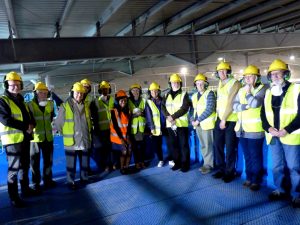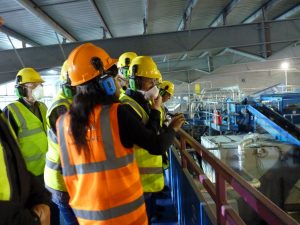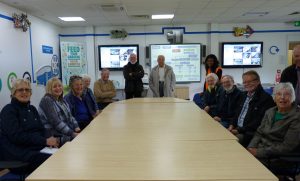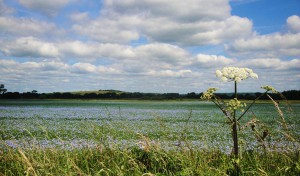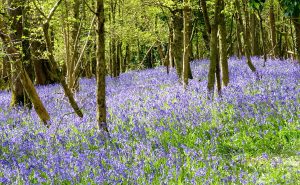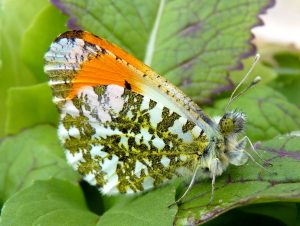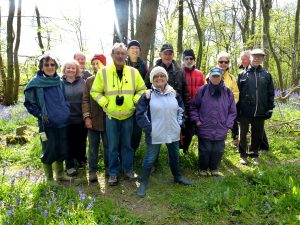Our Member’s Meeting commenced this year with a talk from Clive Hope on ‘Birds at Goring Gap’. Clive began by telling us that already this year skylarks had been seen hovering overhead and were hopefully nesting among the crops. The numbers of these birds are in decline due to modern farming practices so it is reassuring to have them in the vicinity. Last October a short eared owl flew over the beach and was eventually chased off by a crow. Little Egrets, many types of gull and sandwich terns fishing for sand eels, were regular visitors. Brent Geese were sighted from October to March as well as many wading birds such as dunlin, grey plovers and oyster catchers, also Redshank had been seen in pools on the greensward. In August and September large numbers of Ring Plovers were spotted on the beach, well camouflaged against the shingle. Also sanderlings, small plump wading birds, have been seen rushing along the shoreline. Clive told us that according to a ‘Wetlands Bird Survey’ the Goring Gap area is of national significance for the many different bird species it attracts.
Sue Palmer followed with news that 30 members attended the last beach clean on 7th May. This time the weather was kind to the volunteers and altogether 15 bags of rubbish were collected. The beach clean scheduled for Saturday, 17th September will contribute to the Marine Conservation Society (MCS) Nationwide Beach Clean and a comprehensive list of litter found will be submitted to their national survey statistics. The results from the 2015 survey showed that litter had increased and that wet wipes litter was up by 31% and balloons by 11%. The MCS are pushing for deposit return bottles and wet wipes to be flushable. Sue, together with Paula Curran, inspect the local footpaths in Ferring at 15 month intervals. They report any footpaths that have become overgrown to West Sussex County Council who then arrange to carry out the clearance of overhanging branches and brambles etc. Also broken stiles and steps are reported as well as very muddy areas. If some footpaths are impassable, fast track funding can be found for speedy repairs and for hard-core to be laid to improve the path surface.
Gregg Plenty gave a talk entitled ‘Every Cloud has a Silver Lining’ and attempted to cheer us by saying that although conservationists were always ready to depress us with news of everything being in crisis, there were many areas where climate change was beneficial to humans and the animal world. Greg highlighted a newspaper report in March of this year where the RSPB had stated that Climate Change had assisted more UK bird species than it had harmed. The dartford warbler, wren, robin and long tailed tit had all increased in number and most immigrant birds were staying longer. The growing season is now 29 days longer and bee orchids were more abundant. Greg pointed out that as a result of warmer air our energy usage goes down and although the hottest day of the year is getting hotter, the annual minimum temperature has become colder at night by 2% over the last 50 years. Greg left us with the thought that since the early 1980’s little egrets from Southern Europe have been enjoying the varied habitats in Ferring so at least these birds must think it is warmer.
Tricia Hall gave us an informative and interesting talk on Fish. Tricia explained that there are 2 types of fish; bony fish and cartilaginous fish. The bony fish has bones, a swim bladder, gill covers and scales and examples are sea bass, cod and haddock. The sea bass goes a long way out to sea and is covered in scales and a thin layer of skin. Its fins are the main propulsion; the dorsal fin has little bony structures and a pair of pectoral fins and all other fins help propel the fish forward. Behind the head are 4 pairs of gills these are where oxygen is extracted from the water. It has a large mouth with no teeth and a lateral line along its body for detecting other animals in dark water. The cartilaginous fish do not have bones but they do have skeletons and a back bone. An example of this type of fish is a lesser-spotted dogfish which has the usual fins but 5 gills and its mouth is underneath its body. Tricia ended her talk with news that a 20 foot long conger eel had been caught off the coast of Plymouth in Devon.
After tea Mike Hall’s beautiful film ‘Wildlife in Ferring Gardens’ was given a very welcome second showing and Ed Miller concluded the meeting with the news that the campsite proposal for part of the Goring Gap was likely to be refused as there were over 300 objections. The TRO to stop the overnight parking of unoccupied caravans and motorhomes along Marine Drive is likely to come into force soon.

